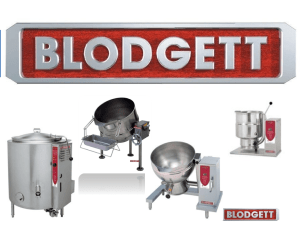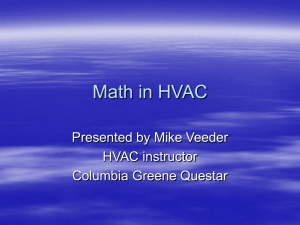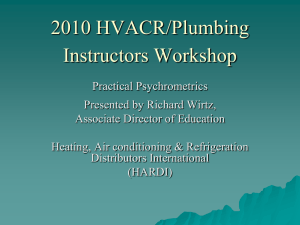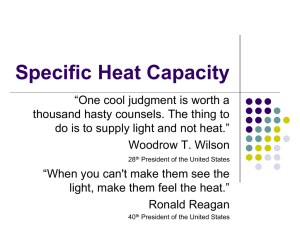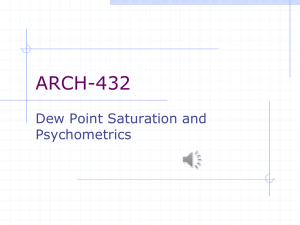Psychrometrics Without Tears
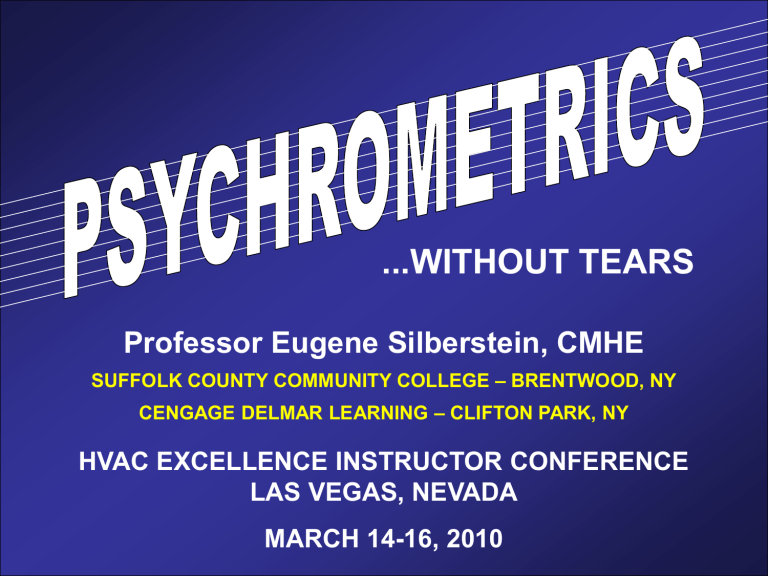
...WITHOUT TEARS
Professor Eugene Silberstein, CMHE
SUFFOLK COUNTY COMMUNITY COLLEGE – BRENTWOOD, NY
CENGAGE DELMAR LEARNING – CLIFTON PARK, NY
HVAC EXCELLENCE INSTRUCTOR CONFERENCE
LAS VEGAS, NEVADA
MARCH 14-16, 2010
What Makes Psychrometrics so
Painful for our Students?
Unfortunately, most of the time it’s us!
How Do We Introduce the Topic?
• You guys are going to hate this
• This stuff is really difficult
• You guys are going to hate this
• This involves a ton of math
• You guys are going to hate this
• You’re not going to understand this but it’s okay because I don’t either
• You guys are going to hate this
• I hate it, so you will also
“This is really going to hurt!”
TEACHING PSYCHROMETRICS IS A LOT LIKE COMMERCIAL FISHING...
How Much Does the Air in this
Room Weigh?
0 pounds? 10 pounds? 50 pounds?
100 pounds? 250 pounds?
500 pounds? 1000 pounds? 1500 pounds?
THE ANSWER MIGHT SURPRISE YOU...
(I Hope It Does!)
Room Dimensions...
• Length: 42 feet
• Width: 42 feet
• Ceiling Height: 16 feet
• Room Volume: 42 x 42 x 16 = 28,224 ft 3
• Based on this volume, the air in this room weighs approximately:
28,224 ft 3 x 0.075 lb/ft 3 =
2,117 POUNDS
The First Four Things...
Dry-Bulb Temperature
Wet-Bulb Temperature
Absolute Humidity
Relative Humidity
TEMPERATURES: WET & DRY
• Are all temperatures created equal?
• Are all pressures created equal?
• What is the difference between psia and psig?
• How do we teach our students the difference?
• How are wet/dry bulb temperatures similar?
• How are wet/dry bulb temperatures different?
• Can we create visual examples?
Dry Bulb Temperature
• Measured with a dry-bulb thermometer
• Measures the level of heat intensity of a substance
• Used to measure and calculate sensible heat and changes in sensible heat levels
• Does not take into account the latent heat aspect
• Room thermostats measure the level of heat intensity in an occupied space
DRY-BULB TEMPERATURE SCALE
As we move up and down, the dry bulb temperature does not change
As we move from left to right, the dry bulb temperature increases
As we move from right to left, the dry bulb temperature decreases
DRY-BULB TEMPERATURE
Wet Bulb Temperature
• Measured with a wet-bulb thermometer
• Temperature reading is affected by the moisture content of the air
• Takes the latent heat aspect into account
• Used in conjunction with the dry-bulb temperature reading to obtain relative humidity readings and other pertinent information regarding an air sample
WET-BULB TEMPERATURE SCALE
As we move up and down along a wetbulb temperature line, the wet bulb temperature does not change
The red arrow indicates an increase in the wet bulb temperature reading
The blue arrow indicates a decrease in the wet bulb temperature reading
WET-BULB, DRY-BULB COMBO
DRY-BULB TEMPERATURE
SLING PSYCHROMETER
75
75
100%
80%
70
70
68
65
65
65 69 70 71 73 75
DRY BULB TEMPERATURE
60%
---- HUMIDITY ----
ABSOLUTELY RELATIVE
• There are two types of humidity
– ABSOLUTE
– RELATIVE
• “AH” and “RH” are not the same
• Cannot be used interchangeably
• All humidities are not created equal
ABSOLUTE HUMIDITY
• Amount of moisture present in an air sample
• Measured in grains per pound of air
60
• 7,000 grains of moisture = 1 pound
1 POUND
The moisture scale on the right-hand side of the chart provides information regarding the absolute humidity of an air sample
MOISTURE CONTENT SCALE
As we move from side to side, the moisture content does not change
As we move up, the moisture content increases
As we move down, the moisture content decreases
WET-BULB, DRY BULB & MOISTURE CONTENT
DRY-BULB TEMPERATURE
RELATIVE HUMIDITY
• Amount of moisture present in an air sample relative to the maximum moisture capacity of the air sample
• Expressed as a percentage
• Can be described as the absolute humidity divided by the maximum moisture-holding capacity of the air
RELATIVE HUMIDITY
Example #1
HOW FULL IS THE PARKING LOT?
RELATIVE HUMIDITY
Example #2
RELATIVE HUMIDITY
Example #3
60
GRAINS
If capacity is 120 grains, then the relative humidity will be:
RH = (60 grains ÷ 120 grains) x 100% = 50%
RELATIVE HUMIDITY SCALE
As we move along a relative humidity line, the relative humidity remains the same
As we move up, the relative humidity increases
As we move down, the relative humidity decreases
WET-BULB, DRY BULB, MOISTURE CONTENT & RELATIVE
HUMIDITY
DRY-BULB TEMPERATURE
The lines that represent constant wet-bulb temperature also represent the enthalpy of the air
ENTHALPY SCALE
As we move up and down along an enthalpy line, the enthalpy does not change
The red arrow indicates an increase in enthalpy
The blue arrow indicates a decrease in enthalpy
WET-BULB, DRY BULB, MOISTURE CONTENT, RELATIVE
HUMIDITY & ENTHALPY
DRY-BULB TEMPERATURE
SPECIFIC VOLUME & DENSITY
• Specific volume and density are reciprocals of each other
• Density = lb/ft 3
• Specific volume = ft 3 /lb
• Density x Specific Volume = 1
• Specific volume can be determined from the psychrometric chart, density muse be calculated
LINES OF SPECIFIC VOLUME
As we move along a line of constant specific volume, the specific volume remains unchanged
As we move to the right, the specific volume increases
As we move to the right, the specific volume increases
WET-BULB, DRY BULB, MOISTURE CONTENT, RELATIVE
HUMIDITY & ENTHALPY
DRY-BULB TEMPERATURE
Return Air: 75 ºFDB, 50% r.h.
Supply Air: 55 ºFDB, 90% r.h.
Airflow: 1200 cfm
SUPPLY AIR
RETURN AIR
ΔT = Return Air Temp – Supply Air Temp
ΔT = 75ºF - 55ºF = 20ºF
ΔW = Return grains/lb
AIR
– Supply grains/lb
AIR
ΔW = 64 Grains – 60 Grains = 4 grains/lb
AIR
Return Air: 75
Supply Air: 55
ºFDB, 50% r.h.
ºFDB, 90% r.h.
Airflow: 1200 cfm h = 28.1 btu/lb
AIR h = 21.6 btu/lb
AIR
Δh = Return btu/lb
AIR
– Supply btu/lb
AIR
Δh = 28.1 btu/lb
AIR
- 21.6 btu/lb
AIR
= 6.5 btu/lb
AIR
RETURN AIR
SUPPLY AIR
64 grains/lb
60 grains/lb
55 ºF 75ºF
AIR FORMULAE
Q
T
= Q
S
+ Q
L
Q
T
= 4.5 x cfm x Δh
Q s
= 1.08 x cfm x ΔT
Q
L
= 0.68 x cfm x ΔW
Yeah, yeah, but where do they come from?
ON PLANET ENEGUE...
100 MILES
HOUR
X
24 HOURS
DAY
X
365 DAYS
YEAR
X
5280 FEET
MILE
100 x 24 x 365 x 5280 FEET
YEAR
X
12 IN
FT
X
2.54 cm
INCH
X
10 mm cm
So, my rate of speed was...
100 x 24 x 365 x 5280 x 12 x 2.54 x 10 mm/year, which is....
1,409,785,344,000 mm/year!
Try These Ideas for Your Students
• If your car get 30 miles per gallon, how many inches per ounce will you be able to travel?
• If you earn $15/Hour, how many pennies per year will you earn in a year if you work 40 hours per week and 50 weeks per year?
• If air weight 0.075 lb per cubic foot how many ounces per cubic inch is that?
Let Students Take Ownership
• Ask the right questions
• Let the students “create” a formula
• Let students identify relevant factors that should be included in the formula
• Let students identify relevant conversion factors that should be included
Total Heat Formula
• We all know Q
T
= 4.5 x CFM x Δ h
• Where does the 4.5 come from?
• Work with the units
– Q
T
(btu/hour)
– What factors will contribute to get this result
– Factors must be relevant to sensible heat
– For example, grains/pound is not a relevant term as it applies to latent heat
Total Heat Formula
• Q
T
(btu/hour)= 4.5 x CFM x Δ h
• Units on the right must be the same as the units on the left
Let the students “BUILD” the Sensible
Heat Formula...
Heat Formulae Variables
So, ask your students what variables and factors will have an effect on the amount of heat transferred by the process
Δh?
Total Heat Formula
We have btu/hour on the left...
btu/hour = ? x ? x ? x ? x ?
Which factor, Δh, ΔW, or ΔT, is associated with the total heat?
btu/hour = Δh (btu/lb
AIR
) x ? x ? x ? x ?
Which other factors are associated with the total heat?
Total Heat Formula
btu/hr = Δh (btu/lb
AIR
) x ? x ? x ? x ?
Airflow btu/hr = Δh (btu/lb
AIR
) x ft 3 /min x ? x ?
btu/hr = Δh (btu/lb
AIR
) x ft 3 /min x 60 min/hr btu/hr = 60 x (btu x ft 3 )/hour x lb
AIR x ?
btu/hr = 60 x (btu x ft 3 )/hour x lb
AIR x ?
We need to get rid of the ft 3 in the numerator and the lb
AIR in the denominator...
What factor relating to air has ft 3 in the denominator and lb in the denominator?
Density btu/hr = 60 x (btu x ft 3 )/hour x lb
AIR x lb/ft 3
Total Heat Formula
Density = 0.075 lb/ft 3 at atmospheric conditions btu/hr = 60 x 0.075 btu/hour
Q
T
(btu/hr) = 4.5 x Airflow x Δh
Sensible Heat Formula
• We all know Q
S
= 1.08 x CFM x ΔT
• Where does the 1.08 come from?
• Work with the units
– Q
S
(btu/hour)
– What factors will contribute to get this result
– Factors must be relevant to sensible heat
– For example, grains/pound is not a relevant term as it applies to latent heat
Sensible Heat Formula
Which factor, Δh, ΔW, or ΔT, is associated with sensible heat?
We already have some of our variables in place btu/hour = cfm x 60 x 0.075 x lb/hour x ? btu/hour = 4.5 x cfm x lb/hour x ?
We need to add the “btu” to the right side and get rid of the “lb” on the right side
Specific Heat
Sensible Heat Formula
The specific heat of air is 0.24 btu/lb/ ºF btu/hour = 4.5 x lb/hour x 0.24 btu/lb btu/hour = 1.08 x btu/hour
Adding in our other variable values gives us:
Q
S
(btu/hr) = 1.08 x Airflow x ΔT
Challenges with the Sensible
Heat Formula
• It doesn’t always give accurate results
• The 1.08 is only an estimate
• The 0.075 lb/ft 3 is not correct most of the time
• The density comes from the specific volume
• Specific volume must be determined
• Specific volume estimate is the average of the values before and after the heat transfer coil
Latent Heat Formula
• We all know Q
L
= 0.68 x CFM x ΔW
• Where does the 0.68 come from?
• Work with the units
– Q
L
(btu/hour)
– What factors will contribute to get this result
– Factors must be relevant to latent heat
– For example, grains/pound is definitely a relevant term as it applies to latent heat
Latent Heat Formula
Which factor, Δh, ΔW, or ΔT, is associated with sensible heat?
ΔW = Change in moisture in grains/lb
AIR
We already have some of our variables in place btu/hour = cfm x 60 x 0.075 x lb/hour x ? btu/hour = 4.5 x cfm x lb
AIR
/hour x ?
btu/hour = 4.5 x cfm x grains/hour x ?
Latent Heat Formula
1 pound of water contains 7000 grains btu/hour = 4.5 x cfm x grains/hour x lb/7000 grains btu/hour = (4.5 ÷ 7000) x cfm x lb/hour
We need to add the “btu” to the right side and get rid of the “lb” on the right side
RETURN AIR
Water Vapor at 75ºF
SUPPLY AIR
Water at 50ºF
STEAM TABLES ACCOMPLISH ONE THING!
Pertinent Enthalpy Information
TEMP °F
ENTHALPY
Saturated
Vapor Btu/Lb
Saturated
Liquid Btu/Lb
38 1078 6
40 1079 8
42 1080 10
44 1081 12
46 1081 14
48 1082 16
50 1083 18
52 1084 20
54 1084 22
56 1085 24
58 1086 26
60 1087 28
62 1088 30
64 1089 32
66 1090 34
TEMP °F
ENTHALPY
Saturated
Vapor Btu/Lb
Saturated
Liquid Btu/Lb
68 1091 36
70 1092 38
72 1093 40
73 1093 41
74 1094 42
75 1094 43
76 1095 44
77 1095 45
78 1096 46
80 1096 48
82 1097 50
84 1098 52
86 1099 54
88 1100 56
90 1100 58
Latent Heat Formula
btu/hour = (4.5 ÷ 7000) x cfm x lb/hour
We need to add the “btu” to the right side and get rid of the “lb” on the right side
From the steam table we get:
1094 btu/lb - 18 btu/lb - 1076 btu/lb btu/hour = [(4.5 x 1076) ÷ 7000] x cfm x lb/hour x btu/lb
Q
L
(btu/hr) = 0.68 x Airflow x ΔW
You can find automated steam tables at: www.efunda.com/Materials/water/steamtable_sat.cfm
Enter Temperature Here
Read Cool Stuff Here
MIXED AIR SYSTEMS
• Return air is mixed with outside air
• Heat transfer coil does not see return air from the occupied space exclusively
• Percentage of outside air changes with its heat content
• Process is governed by an enthalpy control
• The heat transfer coil sees only the mixture of the two air streams
LAW OF THE TEE
• Also known as nodal analysis
• What goes into a tee, must go out!
• Electric circuit applications
• Water flow applications
• Hot water heating applications
• Mixed air applications
5 AMPS
?
2 AMPS
5 GPM
?
2 GPM
5 GPM @ 100 ºF ?
5 GPM @ 140 ºF
5 GPM @ 100 ºF ?
3 GPM @ 140 ºF
Here’s The Math...
(5 GPM x 100 ºF) + (3 GPM x 140ºF) = (8 GPM x YºF)
500 + 420 = 8Y ºF
920 = 8YºF
Y = 115ºF
LAW OF THE TEE FOR WATER
CLASSROOM DEMONSTRATION or EXPERIMENT
40 ºF 70 ºF
1 CUP 1 CUP
Have students predict final mixed temperature.... Then combine, mix, measure and confirm..... Then change the rules!
LAW OF THE TEE FOR WATER
CLASSROOM DEMONSTRATION or EXPERIMENT
THE RESULTS:
15 ºF 15 ºF
40 ºF 55 ºF 70 ºF
LAW OF THE TEE FOR WATER
CLASSROOM DEMONSTRATION or EXPERIMENT
40 ºF 70 ºF
2 CUPS 1 CUP
LAW OF THE TEE FOR WATER
CLASSROOM DEMONSTRATION or EXPERIMENT
THE RESULTS:
10 ºF 20 ºF
40 ºF 50 ºF 70 ºF
LAW OF THE TEE FOR MIXED AIR
OUTSIDE AIR
RETURN AIR
MIXED AIR
AIR
HANDLER
LAW OF THE TEE FOR MIXED AIR
PERCENTAGE OF RETURN AIR
+ PERCENTAGE OF OUTSIDE AIR
100% of MIXED AIR
OUTSIDE
RETURN
LAW OF THE TEE FOR MIXED AIR
SAMPLE PROBLEM
AIR CONDITIONS: RETURN AIR (80%): 75 ºFDB, 50%RH
OUTSIDE AIR (20%): 85ºFDB, 60%RH
MIXED AIR = 80% RETURN AIR + 20% OUTSIDE AIR
MIXED AIR = (.80) RETURN AIR + (.20) OUTSIDE AIR
MIXED AIR = (.80) (75 ºFDB, 50%RH) + (.20) (85ºFDB, 60%RH)
MIXED AIR = 60 ºFDB, 40%RH + 17ºFDB, 12%RH
MIXED AIR = 77 ºFDB, 52%RH
Return Air: 75 ºFDB, 50% r.h.
Outside Air: 85 ºFDB, 60% r.h.
Mixed Air: 77 ºFDB, 52% r.h.
SUPPLY AIR
OUTSIDE AIR
MIXED AIR
RETURN AIR
Eugene Silberstein
917-428-0044 silbere@sunysuffolk.edu


